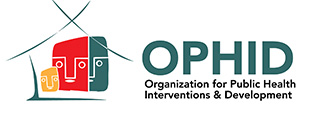Previously known as the Institute of Public Health, Epidemiology and Development (ISPED) of the University of Bordeaux in France, OPHID has been a technical partner supporting the Ministry of Health and Child Care in the implementation of the National Prevention of Mother to Child Transmission (PMTCT) of HIV Program in Zimbabwe since 2001.
OPHID has since grown to be one of the main local stakeholders in the field of HIV Prevention, Care and Treatment. In 2012, OPHID grew from being a sub-recipient to become a Consortium lead and grant holder for a PEPFAR and USAID funded 5-year Families and Communities for the Elimination of Paediatric HIV (FACE HIV) program which ended on the 31st of September 2020.
With support from our funding partners, OPHID is a trusted partner of the Ministry of Health and Child Care at national, provincial, district and community levels. We aim for our programs to be cost-effective, taking advantage of project leverage and integration, joining together expertise in the fields of HIV Prevention, Care and Treatment; Maternal, Neonatal and Child Health; Sexual and Reproductive Health; Early Childhood Development and Women’s Empowerment.
With established local technical expertise in health system strengthening for HIV care and treatment, OPHID and its sub-partners J.F. Kapnek and ZNNP+ proposed a data-driven, clinically-sound program that focuses on strengthening facility implementation under the Target, Accelerate and Sustain Quality Care (TASQC) for HIV epidemic control program. The Goal of the TASQC program is to contribute to the achievement and sustainability of HIV epidemic control in Zimbabwe through the provision of technical, financial, and material support towards the management, coordination and provision of comprehensive clinical care services within the national HIV program. In partnership with the MOHCC and guided by national strategic plans for HIV Prevention, Care and Treatment, the TASQC program will support a package of interventions to strengthen health systems, specifically the bridge between facilities and community structures, the development of innovative, evidence-based models and, design of upgraded tools and relevant technologies to scale up high quality HIV prevention, care and treatment services. The program will integrate three of the four USAID/Zimbabwe’s cross-cutting issues, including gender, youth, and governance in the facility and community.
By the end of 2025, the TASQC program will have supported the MOHCC to have achieved the 95-95-95 targets, by ensuring that 1) more than 95% of HIV positive clients in all sub-population groups will be identified and initiated on treatment in all supported districts, 2) more than 95% of ART clients will be retained on treatment, 3) more than 95% of ART clients will be virally suppressed. The program will have also strengthened in national capacity to collect and analyse data for decision making and have enhanced the engagement of the private sector in the national HIV response.

